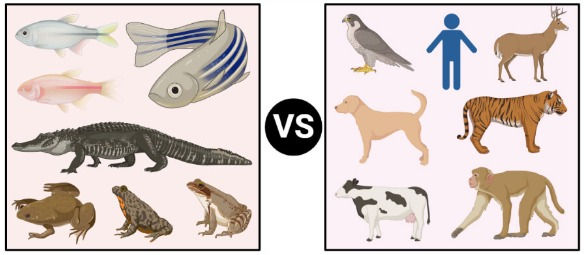Warm-Blooded vs Cold-Blooded Animals
- STEM To Go

- Sep 18, 2020
- 4 min read
You've most likely learned that some animals are categorized as warm-blooded, while others are cold-blooded. However, these labels may be misleading; they don't describe the actual temperature of the organism's blood! So, what exactly do these descriptions entail, and what are the differences between these two types of animals? Continue reading to find out!

The scientific term that differentiates these two groups is thermal homeostasis. Homeostasis is derived from the Greek words meaning "same" and "steady," and is used to describe processes regulated by organisms in order to keep their internal balances at stable levels to survive. Thermal homeostasis in particular describes the process of maintaining a stable internal body temperature.
The different ways animals maintain thermal homeostasis is how they are classified as warm or cold-blooded. The term "warm-blooded" refers to animals whose body temperature can remain stable despite the temperature of the outside environment. In other words, they have the ability to keep the internal temperature of their bodies the same even if the temperature around them changes. For example, you may already know that human body temperatures are always around 35-40 degrees Celsius (95-104 degrees Fahrenheit), never going extremely high or low, even when the weather changes. On the other hand, cold-blooded creatures do not have this ability, which means that their internal body temperature changes with the outside environment and they have to accommodate for that by moving to areas with more tolerable temperatures. Because their temperature levels are constantly fluctuating, their bodies do not maintain thermal homeostasis.
Since cold-blooded animals, such as reptiles and amphibians, cannot maintain thermal homeostasis by themselves, they depend on sunlight to stay warm. This means that they cannot live in extremely cold or hot temperatures, and their body processes, such as metabolic rates, are heavily dependent on the outside temperature. In addition, they may go into hibernation in the winter and aestivation in the summer, both of which are phases of inactivity to maintain survival.
Cold-blooded animals also require less energy because their bodies don't maintain thermal homeostasis. They are also more immune to diseases because if any harmful microorganisms begin growing on their bodies, they can get rid of the disease by lowering their body temperature.
Furthermore, cold-blooded animals can be described according to three different types of cold-bloodedness: ectothermy, poikilothermy, and bradymetabolism. Ectothermy cold-bloodedness describes organisms who depend on the outside climate to gain heat. Poikilothermy goes hand-in-hand with ectothermy, and describes cold-blooded animals whose body temperatures change along with their outside environment. Lastly, bradymetabolism refers to when the body temperature of an organism depends on the rate of metabolism. For instance, bees stay warm by flapping their wings, as this increases the rate of metabolism in their bodies, which increases their overall body temperature.
Warm-blooded animals do not need to go to such measures to maintain their thermal homeostasis, and are able to keep it consistent despite changes in the outside temperature. Most warm-blooded animals are mammals, including us humans! Because warm-blooded animals have to maintain their temperature, their bodies require much more energy and need much more food to survive. This also means that they have a higher stamina level in order for their bodies to continuously work to maintain their temperature. Although they are more prone to disease, they have stronger immune systems since they can't depend on the fluctuation of body temperature to kill of harmful microorganisms. In addition, they do not undergo phases of hibernation or aestivation, as they can maintain a stable body temperature no matter what the environment is. Their adaptivity to different temperatures also means that they can live in a greater variety of environments compared to cold-blooded animals.
So, why do warm-blooded animals have this ability? Within their body cells, there is a structure called the mitochondria, which produces energy used by the body to maintain its temperature. There are additional body processes warm-blooded organisms have to maintain thermal homeostasis, including sweating or panting, which are used to get rid of heat. Additionally, shivering and migrating can occur in colder temperatures. These processes, however, do not depend on circumstances in the outside environment to control body heat.
Like cold-blooded animals, there are also three different types of warm-blooded animals, which are endothermy, homeothermy, and tachymetabolism. Endothermy describes how some animals sweat and shiver to keep their body temperature stable. Homeothermy describes warm-blooded animals that maintain higher body temperatures than their surroundings. Lastly, tachymetabolism, which is the opposite of bradymetabolism, describes the relationship between metabolism and body temperature, and how metabolism rates increase as body temperature increases.
In conclusion, even though these different types of animals have different body systems, all of these processes occur for the ultimate goal of survival. Hope you learned something new about the diversity of body systems within our variety of ecosystems. Thank you for reading!
References:
C, Rachna. “Difference Between Cold-Blooded and Warm-Blooded Animals (with Comparison Chart).” Bio Differences, 3 May 2019, biodifferences.com/difference-between-cold-blooded-and-warm-blooded-animals.html.
Linthicum, Will. "Animal Body Types." Union College, 15 Nov. 2011, http://minerva.union.edu/linthicw/index.htm.
“What Is Homeostasis?” Scientific American, 3 Jan. 2000, www.scientificamerican.com/article/what-is-homeostasis.




Comments